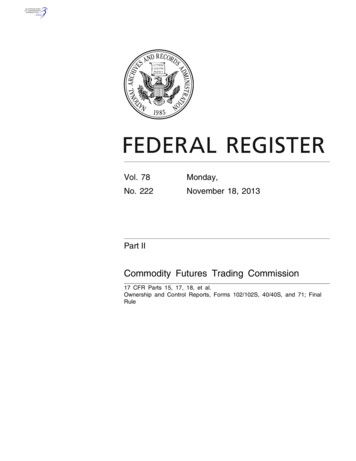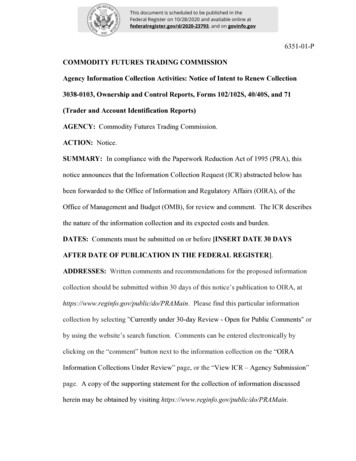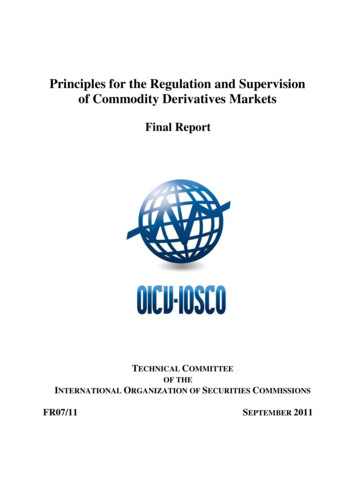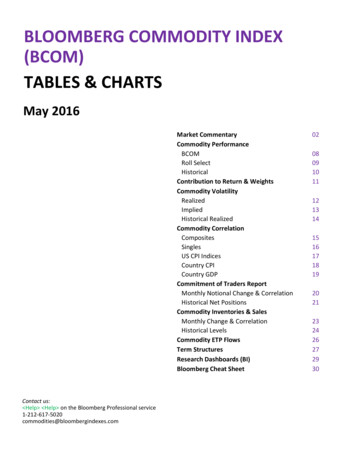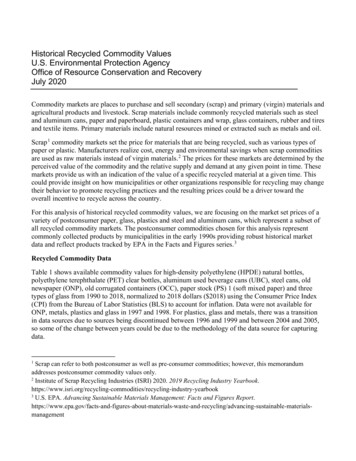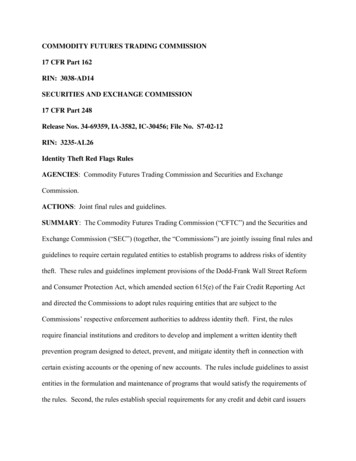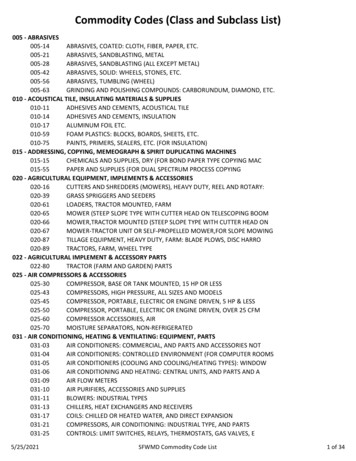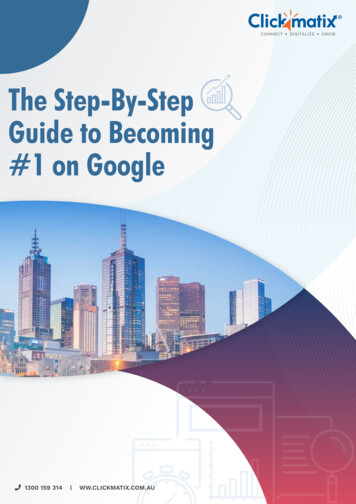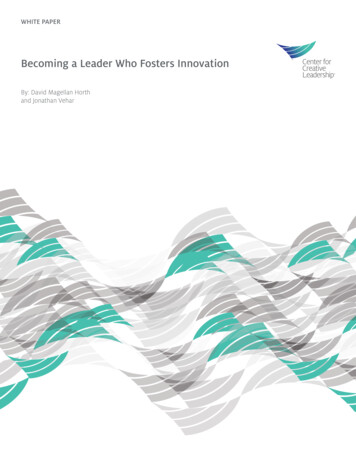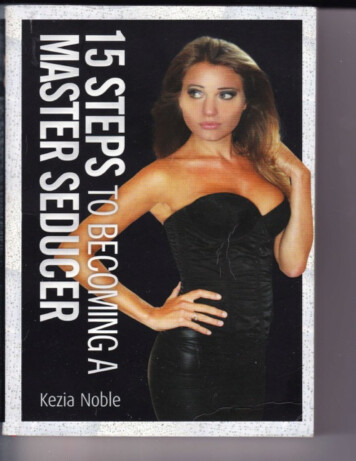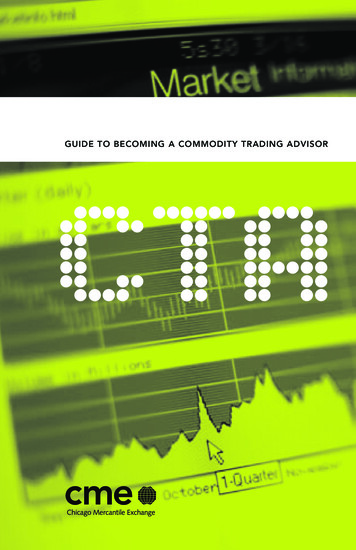
Transcription
GUIDE TO BECOMING A COMMODITY TRADING ADVISOR
Guide to Becoming a CTADean E. Lundell Copyright 2004 Chicago Mercantile ExchangeGuide to Becoming a CTA 1
TA B L E O F C O N T E N T S5AcknowledgementsChapter One7Market Trends for Alternative InvestmentsChapter Two9The Business of Being a CTABusiness Plan and StructureStaffingGrowth ManagementOffice Equipment and Trading SystemsStart-Up CostsBrokerage Firms and Commission RatesCommissions and ClientsExecution ServicesProfessional ServicesChapter Three15Creating Your Trading ProductOverviewMechanical SystemsDiscretionary StrategiesDiversified StrategiesSingle Sector StrategiesStrategy Design and TestingSlippage ControlInstitutional vs. Retail InvestorsChapter Four23Marketing Your CTA BusinessTrack RecordRaising FundsAccount SizesProfessional Money RaisersClient RelationshipsNational Futures Association RulesChapter Five31The Measures of CTA SuccessPerformance and Consistency of ReturnsLimiting DrawdownsLength of Track RecordBecoming EstablishedRates of Growth2 Guide to Becoming a CTA
Chapter Six35Risk Management for CTAsDiversificationRisk per TradePosition Sizes and Risk ExposureTrading in UnitsKick-Out LevelsVolatility Measurement and ControlMargin-to-Equity RatioCommission-to-Equity RatioStop OrdersCommon QuestionsChapter Seven43CTA Performance RecordsRegulatory RequirementsProprietary Performance RecordSimulated or Hypothetical ReportsComposite Performance RecordsRate of Return CalculationsEstablishing Your Performance RecordChapter Eight47CTA FeesCompensation ComponentsChapter Nine51CTA Registration and AuditsRegistration RequirementsDisclosure DocumentsRecord Keeping RequirementsAudit ReadinessGeneral InformationRecordsAdvertising, Communications and Customer ComplaintsFees and Order AllocationPerformance Record TestingManuals and DocumentationExit InterviewChapter Ten59From Floor Trader to CTAThe Transition from the Floor to UpstairsThe Skills You Have and the Skills You Will NeedGuide to Becoming a CTA 3
Table of Contents (continued)Appendix I63Risk Control SystemCourtesy, Mr. Thomas BassoAppendix II65Measuring Futures VolatilityCourtesy, Mr. Thomas BassoAppendix III67Sample Performance RecordNotes to Performance TableCourtesy, Mr. Michael LiccarAppendix IV71“How to Survive Your First NFA Audit”First published in MFA Journal, December 1992By Mr. Thomas P. Schneider, reprinted with permission77Glossary81Index86Resources4 Guide to Becoming a CTA
ACKNOWLEDGEMENTSTo the consulting firm of Greenwich Associates for supplying facts and figureson alternative investments; to Sol Waksman and The Barclay Group for their indepth analysis of managed futures demographics; and to the Futures IndustryAssociation for their help.Many thanks to Charles Mizrahi, a former floor trader on the NYFE and retiredChief Executive Officer of Hampton Investors, a CTA that he founded.Thanks as well to William Taki who co-founded Baldwin CTA, MC BFC CPOand CF Asset Management, LLC, and is currently co-founding partner andprincipal of CTA, Phoenix Global Advisors, LLC.Thanks also to Stephen Heilman, CME floor trader, CTA and President ofAugustan Capital Management, LLC.Original panels moderated by: Ms. Patricia N. GillmanThis book is an updated version of an original developed in 1994. It is a compilation and distillation of remarks made by the following individuals at a series ofseminars hosted by Ms. Patricia N. Gillman and Chicago Mercantile Exchangein May 1992, January 1993, May 1993, September 1993 and March 1994. Manythanks to the following panelists that participated in those seminars: Includedare their credentials at the time.Mr. Greg AndersonCTA and CPOMr. Tom BassoCTAMr. Doug BryCTAMr. David ChevalCTA and CPOMs. Laleen DoerrerMoney RaiserMs. Audrey GaleCTA Marketer/AdministratorMs. Patricia N. GilmanAttorneyMs. Malinda GoldsmithCTAMr. Yra HarrisFloor Trader and Former CTAMr. Joe KrutsingerFCMMr. Michael LiccarAccountantMr. Edwin L. MillerCTA and CPOMr. Joe NicholasCTA ConsultantMr. Craig PaulyCTA and CPOMr. Jeff QuintoFCMMr. Thomas P. Schneider CTA“How to Survive Your First NFA Audit”MFA Journal, Appendix IVSeptember 1993January 1993March 1994May 1993January 1993September 1993All SeminarsMarch 1994May 1993January 1993May 1992September 1993May 1993May 1992March 1994December 1992Guide to Becoming a CTA 5
Although a number of years have passed since those first seminars, the pagesstill offer the reader valuable insights and useful advice on what it takes tobecome a successful CTA (Commodity Trading Advisor). It is our sincere hopethat you will find value in the wisdom contained in these pages.About the authorThe author, Dean Lundell, has been a Vice President at Merrill Lynch CapitalMarkets, a Principal of a regional investment bank and is, of course, a CTA. Heis the author of Sun Tzu’s Art of War for Traders and Investors (McGraw-Hill)and has written numerous publications for private audiences on interest ratederivatives and foreign exchange, corporate and investment banking and thefixed-income markets.The views expressed in this handbook are those of the original panelists and participants andthose who offered their quotes and experience, and do not necessarily reflect the views of CME,its members, employees or contractors. No endorsement of services provided by any of theoriginal panelists or participants or current contributors, employees or contractors is intended byinclusion of their remarks in this handbook. All matters pertaining to rules and specifications aremade subject to and are superseded by official CME rules and applicable Commodity FuturesTrading Commission and National Futures Association rules and regulations.Trading in futures contracts and options on futures contracts is not appropriate for all persons. Itshould never be engaged in by any person who does not have sufficient, accurate and balancedinformation about the investment being considered, including a clear description and explanationof the risks.Examples in this publication are based on hypothetical fact situations and should not be considered investment advice. Some of the items in this publication are based on secondary materialswhich are believed to be reliable, but which are not guaranteed as to accuracy or completeness.This publication was developed for general educational purposes and is not a substitute forany prospectus, disclosure document, or other document that is required to be given toprospective customers.Past performance figures are not necessarily indicative of future returns or results.The Globe logo, Chicago Mercantile Exchange and CME are trademarks of ChicagoMercantile Exchange Inc. All other trademarks are the property of their respective owners.6 Guide to Becoming a CTA
MARKET TRENDS FORALTERNATIVE INVESTMENTSCHAPTER1
Market Trends for Alternative InvestmentsAlternative InvestmentsAlternative investments can encompass a wide variety of investment vehicles,among which are certain fixed-income instruments, equity real estate, privateequity, hedge funds, and of course managed futures.The trend for institutional participation in alternative markets is clearly on therise on a global basis, with the exception of Japan. Geographic areas thathave seen the greatest expansion in allocations to this broad asset categoryare North America, continental Europe, the United Kingdom and Australia.As of early 2004, allocations to alternative investments, including managedfutures, comprise almost 14 percent of investment dollars in Australia,(although that is a relatively small market), 9.5 percent in Canada, 7.5 percentin the United States, 8 percent in continental Europe, and 7 percent in theUnited Kingdom, while Japan lags at only 0.6 percent.There is a wide disparity among institutional investors in regard to the percentages of funds they have invested in alternative markets, particularlybetween pension funds and endowment funds and foundations. On a globalbasis, endowment funds and foundations are most involved in these markets,with roughly 20 percent of their assets in alternative investments, while pension funds lag this trend significantly.The growth in managed futures over the past 25 years has been truly exponential. According to The Barclay Group, which monitors assets under management, CTAs (Commodity Trading Advisors) were managing 310 million in1980. By 1990, that figure was 10.5 billion; by 2000 it was 37.9 billon and in2003 it totaled 86.5 billion. These figures are echoed in the substantialincreases in trading volume on futures exchanges around the globe.Electronic trading has certainly played a major role in contributing to thisextraordinary growth. There is no mistaking the trend. For more information,visit www.barclaygrp.com.Even hedge funds, which have tended to eschew the institutional marketbecause they were unwilling to reveal certain portfolio characteristics, are nowparticipating extensively in managed futures. As a CTA, and therefore as aninstitutional investor, you will have a fiduciary responsibility to perform duediligence. You will not have to reveal everything, but you will have to be prepared to explain the value proposition of your trading program.Guide to Becoming a CTA 7
Market Trends for Alternative InvestmentsThe principal reason institutional investors participate in the managed futuresmarket is the non-correlation of futures returns to traditional equity and debtinvestments. Although futures provide an attractive vehicle for diversifying totalportfolio risk, managing and monitoring futures takes a disproportionalamount of resources on the part of investors. Therefore, one of the mosteffective ways a CTA can secure assets to manage from these investors is tomake it easy—and worthwhile—for them to do just that.8 Guide to Becoming a CTA
THE BUSINESS OF BEING A CTACHAPTER2
The Business of Being a CTABusiness Plan and StructureBeing a CTA and managing other people’s money is a business and should betreated as such. You have to think about it as any new business venture. Takethe time to write a comprehensive business plan. Take an inventory of yourstrengths, your weaknesses, resources and skills. It’s important to be honest withyourself and with your potential clients. If there is a deficiency somewhere, finda way to address it.Although working with a partner can certainly have its advantages, it would bevery much worth your while to incorporate, rather than being a sole proprietor.Make sure you have in writing what is going to happen in the event somethinggoes wrong. This is a business like any other and it makes sense to protectyourself and your business. Make sure you secure the services of an attorney.There are no hard and fast rules concerning areas of responsibility inpartnerships. In some instances, partners do not allocate those areas ofresponsibility; in others they do. Some partners compare and contrast theirthoughts and opinions and arrive at a consensus before executing any trade.On the flip side, other firms will have dedicated principals that focus on aparticular market sector or segment. Admittedly, this approach has thepotential to lead to problems concerning unequal performance or assetallocation to various market segments.StaffingAs a new CTA, you may have a modest amount of assets under management.You may need an assistant, but you can hire people who do not necessarilyhave to be employees of the firm. You can also outsource certain aspects ofyour business to professionals such as legal or accounting firms.For example, you may have accounts at several different Futures CommissionMerchants (FCMs). Instead of placing all your individual orders with each FCM,you could select someone to do give-ups on your behalf.The basic concept is do not attempt to do everything by yourself. If you are atall successful at raising money and trading the markets, you will very soon bemuch too busy with the markets.Certainly, at a minimum, you are going to need people for clerical functionssuch as keeping track of your equity run, collecting fees and providing generaloperational functions, and that doesn’t begin to address the problem ofmarketing yourself, which has become a professional function unto itself.Guide to Becoming a CTA 9
The Business of Being a Commodity Trading Advisor (CTA)It would be very much worth your while to have an assistant or partner whocan run the company, talk to clients and eventually help with trading. This willenable you to concentrate on trading, not talking with clients and assumingother administrative duties. A partner or assistant functioning as your “tradingconscience” can be worthwhile if you are a discretionary trader. This shouldbe someone that you know and trust and who knows how you trade. Youneed someone with the ability to ask, “What are you thinking?” This personcan help keep you on track. Systems traders, however, generally, do not havethis particular problem, since the system makes the trading decisions.Growth ManagementHow you are going to raise money will often dictate what you are going toneed to set up your office. Are you going to have a single pool of funds or willyou raise funds yourself from a variety of sources? Your administrative needswill also multiply if you decide to trade in the cash markets, such as foreignexchange, or perhaps trade in foreign markets. Participate in either of thosemarkets and you will have to have someone on-call 24 hours a day.You could experience growth in several ways, not just assets under management: The number of Futures Commission Merchants you are dealing with. Anincrease here may very well demonstrate the need for someone to processtrades, report give-ups and check positions daily. Trading various cash markets in addition to the futures markets. You mayfind that you need to hire an experienced trader instead of going throughthe learning curve yourself. Trading 24-hour markets. If you choose to do this, you will need someoneto monitor posi
Chapter Ten 59 From Floor Trader to CTA The Transition from the Floor to Upstairs The Skills You Have and the Skills You Will Need Guide to Becoming a CTA3. 4 Guide to Becoming a CTA Appendix I 63 Risk Control System Courtesy, Mr. Thomas Basso Appendix II 65 Measuring Futures Volatility Courtesy, Mr. Thomas Basso Appendix III 67 Sample Performance Record Notes to Performance Table
